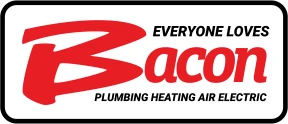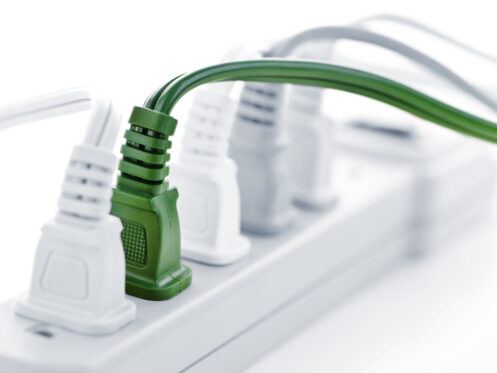Americans lose billions each year due to power surges. Home insurance often does cover damages from a power surge. But there are policy limits, and coverage usually doesn’t extend to ancillary damage, such as food in the refrigerator. Whole-house and other surge protection is an investment in your home. It protects your possessions and will pay for itself over the life of the equipment. You will also have peace of mind because you will not have to spend thousands of dollars replacing appliances, electronic devices and food. Let’s take a deep dive into gaining a better understanding of surge protection and explore how to choose the best protection for your home.
What Is Surge Protection?
A surge protection device (SPD) is an electronic appliance that protects electrically powered equipment against power spikes and surges. A voltage spike is a sudden increase in received voltage that lasts about a nanosecond. A power surge is a sudden increase as well but one that lasts 3 nanoseconds or longer.
Spikes generally involve higher voltages and can cause catastrophic damage. But they’re rarely harmful due to the short duration. Surges typically involve lower voltages but are more likely to cause harm due to the longer duration. It is possible to have a surge preceded and followed by spikes.
Both spikes and surges have many causes, including internal sources, such as faulty wiring, static electricity and magnetic fields. There are also external origins, including lightning strikes and malfunctions from nearby transformers and transmission lines.
The internal workings vary from one SPD to another, but the core principles are the same. An SPD first absorbs the spike or surge. It then passes the current to the ground until voltage normalizes.
What SPD Types Are Available for the Home?
There are three core types of SPDs you’ll want to consider for achieving whole-home protection.
- Type 1 SPDs: Primary Surge or Service Entry Arrestors
- Type 2 SPDs: Main Distribution Panel Surge Protectors
- Type 3 SPDs: Point-of-Use Surge Protectors
T1 SPDs
A T1 SPD is a hard-wired and permanently connected device. For residential applications, an electrician will install it between the utility service and the side of the main electrical panel where the line is located. T1s support much higher voltages. They’re designed to protect your entire electrical system from high-energy surges from external sources. These include direct lightning strikes and substantial overvoltage coming from the grid.
T2 SPDs
A T2 SPD is also a hard-wired and permanently connected device. The difference is that the electrician will install it on the load side of the main service panel. This is the side where power is branching out to your lights, air conditioning, refrigerator and so forth. T2s are effective at protecting electronics from spikes and surges originating internally and from residual lightning energy.
T3 SPDs
T3s generally don’t require an electrician. These are the common surge protectors available at retail. They’re usually purchased and installed by the consumer and not hard wired or permanently installed. Point-of-use surge protectors safeguard against transient voltages and low-level surges. They’re highly effective at providing localized protection for your most valuable and delicate electronic equipment.
What Is a Type 1+2 SPD?
A T1+T2 SPD is not an alternative to having a discrete T1 and T2 installed. These devices do combine the surge arresting principles of T1s and T2s. But they’re designed to handle additional energies with low-surge voltage pulses. If needed, an electrician will install a T1+T2 in addition to a T1 and T2.
Other Types
There are also T4 and T5 SPDs. Electricians use these in particular wiring configurations. But they’re generally used in commercial and industrial applications and rarely in residential applications.
Surge Protector vs. Power Strip
There are many different styles of POU surge protectors available. The most common is the surge protector strip, which is both a surge protector and a power strip. While many are, not all power strips are surge protectors. Those that aren’t will not provide any protection for your devices.
Which Type of Whole-Home Surge Protection Do You Need?
Electricians recommend a cascading approach to surge protection for your home. Consider that no particular type of surge protection will protect you comprehensively. While a T2 is all you technically need for surge protection, it alone leaves you exposed. A direct lighting strike to your home, for instance, can easily overwhelm your T2. Likewise, a T2 could do its job and still allow for residual energies that damage your devices that lack T3 protection.
How Do You Size Surge Protection?
There are several important points to understand when sizing whole-home surge protection. It differs between T1, T2 and T3. You need to at least safeguard against the worst-case scenarios. Surge protectors wear down over time, and you’ll eventually need to replace them. This often means there is no such thing as too much surge protection. There are exceptions to this, which is something you should discuss with your electrician. But generally, a bigger SPD will provide you with a longer equipment lifespan.
You generally want a system rated to stop a surge of 40,000 amps at a minimum. The National Electric Manufacturers Association also has a rating system that can be useful. Whole-house surge protection with a NEMA rating of 1 provides a basic level of protection. NEMA 4 indicates the greatest level of protection.
When it comes to T3s, it’s a matter of joules. A T3 rated for 200 to 400 joules provides the minimum level of protection. This is all right when protecting relatively inexpensive devices. A surge protector rated for 1,000 joules provides high protection. You may want to consider 2,000 joules and up for your most prized possessions, such as computers and home theater equipment.
Response Time
Response time is a consideration as well. You generally want a response time less than a nanosecond. Some of the best SPDs for home use have a response time less than 0.25 ns.
Warning Systems
Experts encourage choosing SPDs that have integrated notification systems. These systems can indicate a fault or even impending failure. Some systems notify you via a flashing LED light, an LCD display or a push notification to your phone. This lets you know that you must have an electrician replace the equipment before the next event.
Automatic Shutoff
Many T1, T2 and T3 SPDs with warning systems have automatic shutoff as well. This feature will disable the electrical system at that particular level. This ensures that no event occurs before you can have an electrician service the system.
Whole-Home Surge Protection Installation in Dallas-Fort Worth
If you want your home upgraded with whole-house surge protection in the Dallas-Fort Worth area, Bacon Plumbing Heating Air Electric is here to help. Our electricians also upgrade electrical panels and install lighting, ceiling fans, GCFI outlets, generators and EV charging stations. In addition to electrical work, we provide a wide range of services to help maintain the systems in your home. Our plumbers clean drains, detect and fix leaks and repipe water and gas lines. They install tank and tankless water heaters, sump pumps and water filtration and softening systems. Our team also includes HVAC technicians that install, service and repair all types of heating and cooling systems, such as ducted, ductless, single-zone and multi-zone configurations. We also have indoor air quality specialists on our team that clean ducts and install air purifiers, UV lamps, dehumidifiers and humidifiers. Call us today with any questions or to schedule an appointment.




